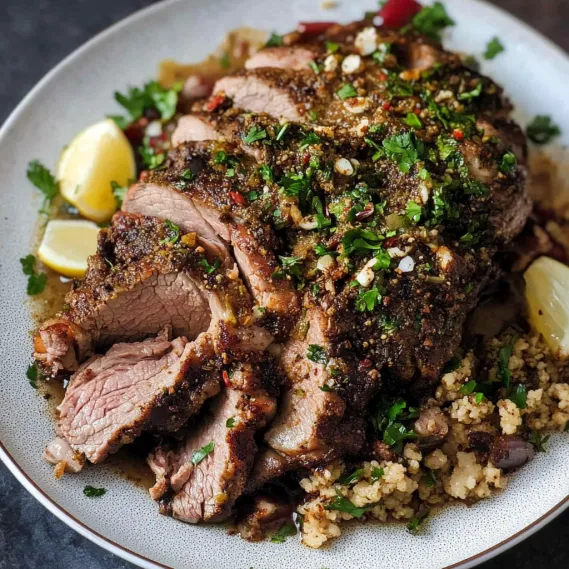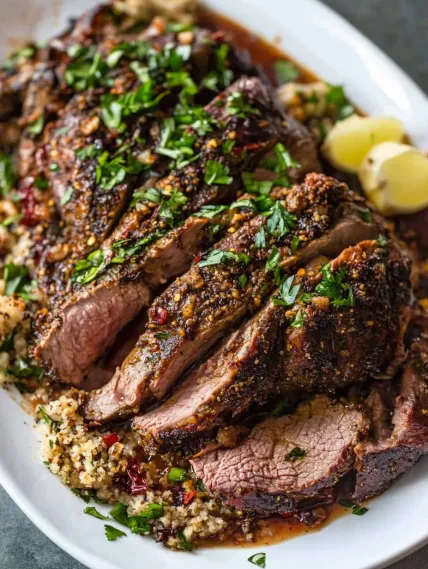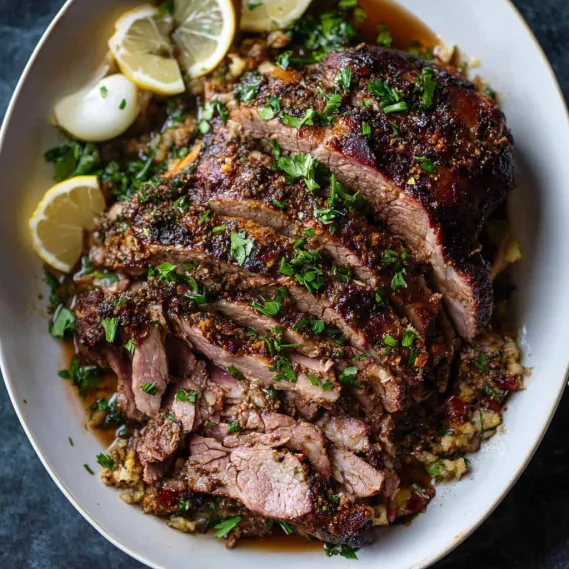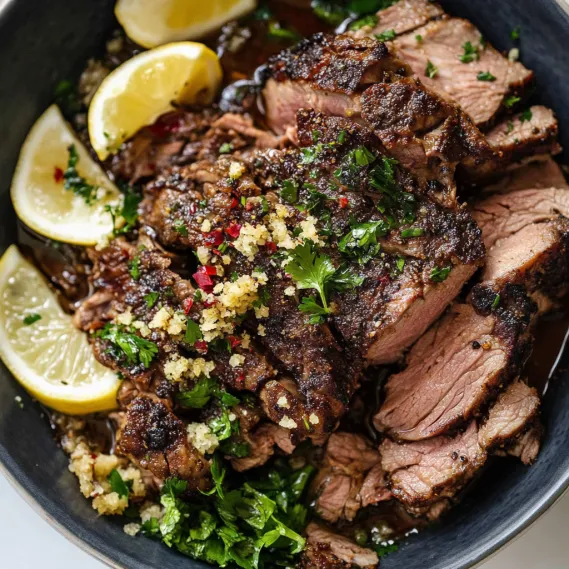 Pin it
Pin it
This meltingly tender lamb shawarma transforms humble ingredients into a spectacular feast with minimal effort. The meat is slathered in an aromatic spice mixture, then slow-roasted until it collapses at the touch of a fork, creating the most heavenly fragrance throughout your home. The beauty of this dish lies in its simplicity – a quick preparation followed by hands-off cooking that yields intensely flavored, succulent meat perfect for feeding a crowd. Whether served in warm flatbreads with fresh toppings or piled onto a platter with colorful sides, this shawarma delivers restaurant-quality taste without requiring a traditional rotating spit.
I first made this for a casual summer gathering, expecting it to be good but not remarkable. The moment I pulled it from the oven and the fragrant steam filled the kitchen, I knew this was something special. My guests actually stood around the cutting board as I shredded the meat, stealing pieces before I could even serve it. What started as a simple dinner became the most talked-about meal I'd hosted in months, with three different friends requesting the recipe before the night was over.
Essential Ingredients and Selection Tips
- Lamb: Either butterflied leg or shoulder works beautifully. Shoulder is fattier and juicier, while leg is leaner but still becomes incredibly tender.
- Shawarma Spices: The magic comes from common pantry spices: cumin, coriander, paprika, cardamom, and cayenne pepper.
- Garlic: Fresh garlic provides an essential aromatic base for the marinade.
- Lemon Juice: The acidity balances the rich meat and helps tenderize it further.
- Olive Oil: Creates a paste with the spices that adheres to the meat during cooking.
I've discovered that lamb shoulder is often overlooked in favor of leg, but it's actually ideal for this recipe. The higher fat content means more flavor and juiciness, and it's usually more affordable. When slow-cooked, that fat melts into the meat, creating an incredible self-basting effect that you just can't replicate with leaner cuts.
Detailed Cooking Instructions
- Step 1: Create Your Aromatic Spice Paste
- Mix 2 tablespoons each of ground cumin and coriander, 1 tablespoon paprika, 1/2 teaspoon cayenne pepper (adjust to your heat preference), 1/2 teaspoon ground cardamom, 1 teaspoon each of salt and black pepper. Add 5 minced garlic cloves, 3 tablespoons olive oil, and the juice of one lemon. Stir to form a thick, aromatic paste that will permeate the meat during cooking.
- Step 2: Prepare Your Lamb For Maximum Flavor
- Pat the lamb dry with paper towels - this ensures the spice paste adheres properly. For shoulder, make deep slashes into the meat. For butterflied leg, open it up fully to expose maximum surface area. Rub the spice mixture thoroughly into all surfaces, working it into cuts and crevices. Let the meat marinate for at least an hour at room temperature, or overnight in the refrigerator for deeper flavor penetration.
- Step 3: Set Up For Perfect Slow Roasting
- Preheat your oven to 325°F/160°C. Place the lamb in a roasting pan and pour 1 cup of water around (not over) the meat. Cover tightly with a double layer of foil, creating a seal that will trap moisture and allow the meat to essentially steam in its own juices while roasting, resulting in the most tender texture possible.
- Step 4: Cook Until Meltingly Tender
- Roast the lamb for approximately 4 hours for a 4-pound piece, or until the meat is completely tender and pulls apart easily with a fork. The exact time will depend on your cut and size - shoulder typically takes longer than leg. Remove the foil during the last 30 minutes of cooking to allow the top to brown slightly while still keeping the meat juicy.
- Step 5: Rest And Finish For Serving
- Allow the lamb to rest for at least 15 minutes before handling. For traditional serving, either slice or shred the meat and drizzle with the flavorful pan juices. For an extra special touch, after shredding, you can finish the meat on a hot grill or under the broiler for a few minutes to create crispy edges that mimic traditional shawarma cooking.
 Pin it
Pin it
The first time I made this recipe, I wasn't sure if the simple spice mixture would create enough flavor without a traditional marinade. I was amazed at how the slow cooking process allows those spices to penetrate deeply into the meat, creating layers of flavor that taste far more complex than the ingredient list would suggest.
The Secret To Perfect Wok Technique
High heat is essential for authentic fried rice. My grandmother taught me to heat the wok until smoking before adding oil. Keep ingredients moving constantly to achieve that elusive "wok hei" flavor. Never overcrowd the pan—cook in batches instead. This technique transformed my fried rice into restaurant-quality perfection.
 Pin it
Pin it
Making The Most Of Leftovers
This dish excels at transforming leftovers into something exciting. I've used roast chicken, holiday ham, and even Thanksgiving turkey with great success. Cut meat into uniform pieces that distribute evenly throughout. Leftover grilled steak adds incredible depth with its smoky edges. Even roasted vegetables bring delightful caramelized sweetness.
Balancing Flavors And Textures
Special fried rice succeeds through balanced components. Char siu provides richness, prawns add sweetness, eggs contribute silkiness, while vegetables offer freshness. The sequence matters—aromatics first build flavor, eggs midway remain distinct, vegetables maintain crispness. Adding spring onions last preserves their brightness for that authentic restaurant finish.
Customization For Dietary Needs
This dish adapts easily to dietary restrictions. For vegetarians, I omit meat, double eggs and add extra vegetables. Low-carb diners enjoy my cauliflower rice version that carries flavors beautifully. For gluten-sensitive guests, tamari replaces soy sauce while ensuring chicken powder is certified gluten-free. Everyone enjoys this beloved dish regardless of restrictions.
Versatile Serving Suggestions
One of the things I love most about this lamb shawarma is its versatility. For casual gatherings, I serve it doner kebab style – sliced and piled into warm flatbreads with shredded lettuce, diced tomatoes, thinly sliced red onion, and a drizzle of cooling yogurt sauce. For more formal occasions, I arrange the meat on a large platter surrounded by lemon herb couscous, roasted vegetables, and small bowls of hummus and tzatziki. When entertaining guests with varying dietary needs, I create a build-your-own shawarma station with the lamb as the centerpiece, complemented by both traditional pita bread and lettuce cups for low-carb options.
Make-Ahead Strategy For Effortless Entertaining
This lamb shawarma has become my go-to for stress-free hosting because it can be prepared entirely in advance. I often cook the lamb the day before, refrigerate it whole in its juices, then reheat gently in a low oven before serving. Not only does this save time on the day of the gathering, but the flavors actually intensify overnight. For the most impressive presentation, I reheat the whole piece, then finish portions on a hot grill just before serving. This creates those beautiful crispy edges that mimic traditional shawarma cooking while maintaining the meat's incredible tenderness.
Cultural Connection And Authenticity
While traditional shawarma is cooked on a vertical rotisserie, this home version captures the essence of the dish through its spice profile and preparation method. I learned from a Lebanese friend that the key to authentic flavor is balancing the earthy spices with enough acidity from the lemon juice. She also taught me to never skip the rest period after cooking – this allows the meat fibers to relax and reabsorb juices, resulting in the most succulent texture. Though this recipe uses modern conveniences like an oven rather than a traditional spit, the result honors the culinary heritage that inspired it.
 Pin it
Pin it
This slow-cooked lamb shawarma has become my signature dish for gatherings, the one that friends and family request most frequently. There's something magical about transforming a simple cut of meat into something so deeply flavorful that it creates instant connections around the table. The combination of minimal active preparation with maximum flavor reward makes it perfect for both special occasions and upgraded weeknight meals. While it may not be the daintiest or most refined dish, its rustic, generous nature embodies what sharing food is truly about – bringing people together over something simply delicious.
Frequently Asked Questions
- → Which cut of lamb works best for this recipe?
- Both lamb shoulder and leg work beautifully in this recipe. Lamb shoulder has more fat marbled throughout, making it slightly juicier and better for reheating. Lamb leg is leaner but still delicious. If using leg, a butterflied cut is ideal as it allows the spice paste to penetrate more of the meat. If using bone-in leg, marinating becomes more important to ensure flavor throughout.
- → Is it necessary to marinate the lamb before cooking?
- Marinating is optional for this recipe because the long, slow cooking time allows the spices to penetrate the meat effectively. However, if you're using bone-in lamb leg, marinating for 24 hours is recommended to ensure the flavors reach deeper into the meat. For shoulder or butterflied leg, you can skip marinating if you're short on time.
- → Can I make this recipe in a slow cooker instead of the oven?
- Absolutely! This recipe works wonderfully in a slow cooker. Reduce the water to 1 cup and cook on low for 10 hours. After slow cooking, you can finish the lamb either in a hot oven (uncovered) for 30 minutes or on the BBQ to develop a nice crust. Just make sure your slow cooker is large enough to fit the lamb comfortably.
- → How can I prepare this dish ahead of time for a gathering?
- This is an excellent make-ahead dish, especially when using lamb shoulder. Cook the lamb completely, then let it cool and refrigerate it submerged in its own pan juices. To reheat, either cover and warm in a 160°C/320°F oven for about 20 minutes, microwave until hot, or bring to room temperature and reheat on a medium BBQ, basting frequently with the reserved juices.
- → What's the best way to serve lamb shawarma?
- There are two classic ways to serve this lamb shawarma: 1) As wraps - shred the lamb and serve with flatbreads, shredded lettuce, tomatoes, and minted yogurt (Greek yogurt mixed with fresh mint, lemon juice, olive oil, and salt); or 2) Over Lemon Herb Couscous - pile the lamb over couscous mixed with dried fruits, fresh herbs, and lemon, then garnish with pomegranate seeds and more herbs.
- → Is the BBQ finishing step really necessary?
- The BBQ finishing step is completely optional but highly recommended if possible. It creates an amazing caramelized crust on the outside of the lamb and adds another dimension of flavor. It's also particularly useful for reheating the lamb if you've made it ahead. If you don't have access to a BBQ, the additional 30 minutes of uncovered roasting in the oven will still give you a nice crust.
